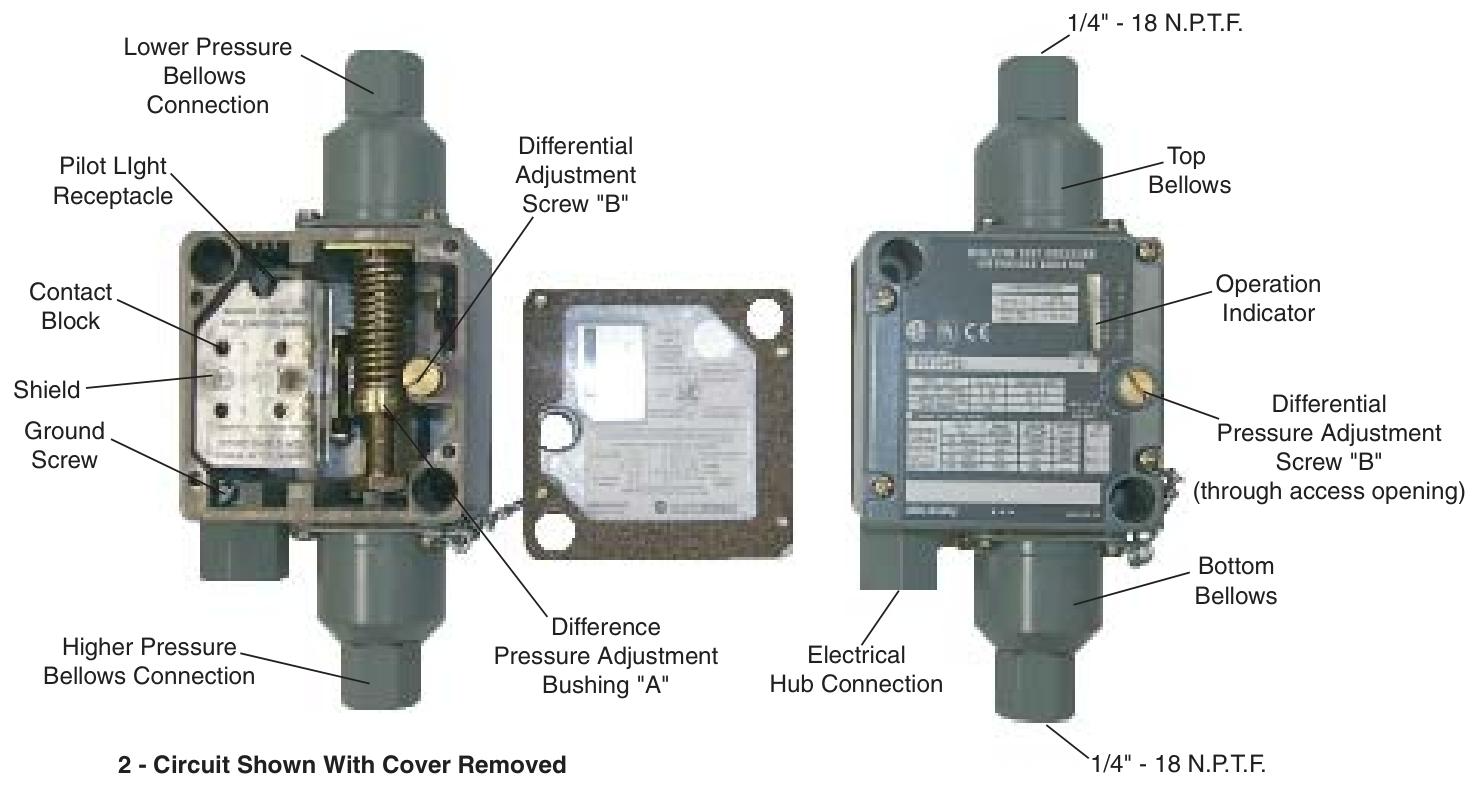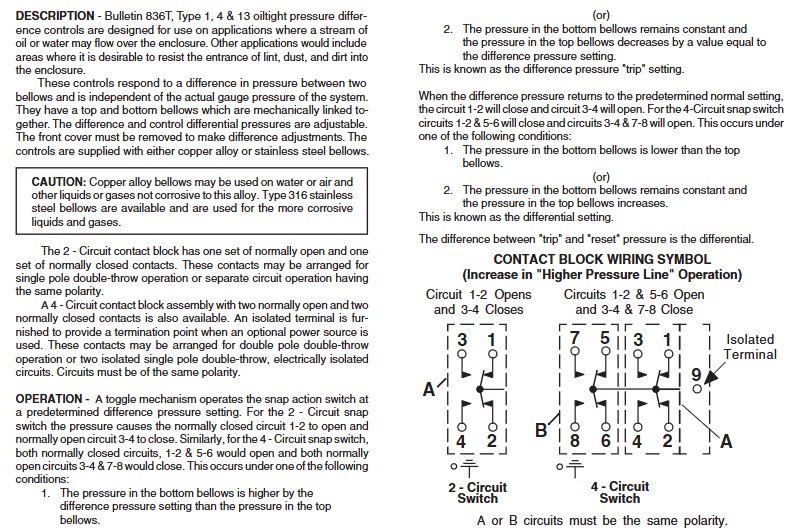Rockwell Automation 836T Series Differential Pressure Controller
Protection ability: It can resist oil/water flow erosion, prevent cotton wool and dust from entering the shell, and is suitable for scenarios that require environmental sealing.
Rockwell Automation 836T Series Differential Pressure Controller
Product Core Description
1. Basic specifications and applicable scenarios
Model classification: Bulletin 836T, including three types: Type 1, 4, and 13, all designed to be oil tight.
Protection ability: It can resist oil/water flow erosion, prevent cotton wool and dust from entering the shell, and is suitable for scenarios that require environmental sealing.
Connection specifications: The pressure interface is 1/4 "-18 N.P.T.F (American dry sealed cone pipe thread), and the electrical interface includes 1/2" -14 N.P.T (optional Pg 13.5 BS20 specification).
Bellows material: provides two options, each suitable for different media——
Copper alloy corrugated pipe: suitable for water, air, and non corrosive liquids/gases;
316 stainless steel corrugated pipe: suitable for liquids/gases with stronger corrosiveness.
2. Core Structure and Function
Core components: including Top Bellows, Bottom Bellows (mechanical linkage), Contact Block, Adjustment Differential Screw "B", Pressure Adjustment Difference Bushing "A", Operation Indicator, optional Pilot Light, etc.
Pressure sensing principle: The action is triggered by the pressure difference between two corrugated tubes, regardless of the actual gauge pressure of the system; Adjustable "trip pressure" and "reset pressure", with the difference between the two being the "differential control pressure".
Contact module configuration: provides two specifications to meet different circuit requirements——
Contact module type Contact configuration Circuit function
2-circuit: 1 set of normally open (NO)+1 set of normally closed (NC) supports single pole double throw (SPDT) or independent circuit operation with the same polarity
4-circuit with 2 sets of normally open (NO) and 2 sets of normally closed (NC) supports double pole double throw (DPDT) or two sets of electrically isolated single pole double throw circuits, including isolated terminal 9, which can be connected to external power supply

Working principle
The controller responds to pressure difference changes through a "trigger reset" cycle, with the following specific logic:
1. Trigger (Trip) action (contact switching)
When any of the following conditions are met, the contact module switches states:
The pressure of the bottom corrugated pipe is higher than the preset trigger pressure difference of the top corrugated pipe;
The pressure of the bottom corrugated tube is constant, and the pressure of the top corrugated tube decreases by the preset trigger pressure difference.
2-channel circuit: normally closed circuit (1-2) is open, normally open circuit (3-4) is closed;
4-channel circuit: Two sets of normally closed circuits (1-2, 5-6) are disconnected, and two sets of normally open circuits (3-4, 7-8) are closed.
2. Reset action (contact recovery)
When any of the following conditions are met, the contact returns to its initial state:
The pressure of the bottom corrugated pipe is lower than that of the top corrugated pipe;
The pressure of the bottom corrugated pipe remains constant, while the pressure of the top corrugated pipe increases.
2-channel circuit: normally closed circuit (1-2) is closed, normally open circuit (3-4) is open;
4-channel circuit: Two sets of normally closed circuits (1-2, 5-6) are closed, and two sets of normally open circuits (3-4, 7-8) are disconnected.
3. Key definitions
Trip Pressure: The minimum pressure difference required to trigger contact switching;
Reset Pressure: The maximum pressure difference that triggers contact recovery;
Differential control: The difference between the trigger pressure and the reset pressure can be independently adjusted.
Installation requirements
1. Mechanical installation
Fixing method: It needs to be fixed on a stable base with two screws, and the installation hole specification is "2-17/64" diameter (6.75mm)+2-23/32 "countersunk hole (69mm)", which can be operated without disassembling the front cover;
Prohibited operation: Do not support the controller solely through electrical or pressure interfaces; When tightening the electrical and pressure interfaces, a support wrench should be used to avoid damaging the components.
2. Precautions for Pre Installation
Before installation, it is necessary to complete the parameter settings ("Setting Control" steps) according to the instructions, otherwise the system cannot be connected;
The pressure interface distinguishes between the "Lower Pressure Bellows Connection" and the "Higher Pressure Bellows Connection", which need to be connected to the corresponding system.

Parameter setting steps
The factory default setting is "maximum trigger pressure difference+minimum control pressure difference" (adjusting the sleeve "A" about 1 inch from the bottom of the housing), which requires the assistance of a pressure gauge for calibration. It is divided into two steps:
1. Trigger the Difference Pressure Setting
The top corrugated pipe is vented to the atmosphere (without pressure), and a constant pressure is applied to the bottom corrugated pipe to trigger the target pressure difference;
- EMERSON
- Honeywell
- CTI
- Rolls-Royce
- General Electric
- Woodward
- Yaskawa
- xYCOM
- Motorola
- Siemens
- Rockwell
- ABB
- B&R
- HIMA
- Construction site
- electricity
- Automobile market
- PLC
- DCS
- Motor drivers
- VSD
- Implications
- cement
- CO2
- CEM
- methane
- Artificial intelligence
- Titanic
- Solar energy
- Hydrogen fuel cell
- Hydrogen and fuel cells
- Hydrogen and oxygen fuel cells
- tyre
- Chemical fiber
- dynamo
- corpuscle
- Pulp and paper
- printing
- fossil
- FANUC
- Food and beverage
- Life science
- Sewage treatment
- Personal care
- electricity
- boats
- infrastructure
- Automobile industry
- metallurgy
- Nuclear power generation
- Geothermal power generation
- Water and wastewater
- Infrastructure construction
- Mine hazard
- steel
- papermaking
- Natural gas industry
- Infrastructure construction
- Power and energy
- Rubber and plastic
- Renewable energy
- pharmacy
- mining
- Plastic industry
- Schneider
- Kongsberg
- NI
- Wind energy
- International petroleum
- International new energy network
- gas
- WATLOW
- ProSoft
- SEW
- wind
- ADVANCED
- Reliance
- YOKOGAWA
- TRICONEX
- FOXBORO
- METSO
- MAN
- Advantest
- ADVANCED
- ALSTOM
- Control Wave
- AB
- AMAT
- STUDER
- KONGSBERG
- MOTOROLA
- DANAHER MOTION
- Bently
- Galil
- EATON
- MOLEX
- Triconex
- DEIF
- B&W
- ZYGO
- Aerotech
- DANFOSS
- KOLLMORGEN
- Beijer
- Endress+Hauser
- MOOG
- KB
- Moxa
- Rexroth
- YAMAHA
- Johnson
- Westinghouse
- WAGO
- TOSHIBA
- TEKTRONIX
- BENDER
- BMCM
- SMC


Email:wang@kongjiangauto.com




































































































































